Frost Tender But Remarkably Fuss-Free – Gazania ‘Treasure Flower’ Growing Tips

ANNUALS > GAZANIA
Reviewed By ROY NICOL

Roy is a Professional Gardener and Horticultural Consultant, specialising in large garden year-round maintenance and garden development. He is an RHS Master of Horticulture and uses his research in the application of no-dig methods in ornamental garden settings. Roy has been a Professional Gardener for more than six years and is a member of the Chartered Institute of Horticulture, Professional Gardener's Guild and Association of Professional Landscapers (Professional Gardener).
IN THIS GUIDE
GAZANIA GUIDES
So colourful, so bubbly, so attractive, Gazanias are almost cartoon flowers!
They are small, evergreen perennial plants that are frost-tender but are remarkably fuss-free and easy to grow.
Bearing flowers in every hue of the warm spectrum, they will bring good cheer to any garden.
Visualise the simple, innocent charms of the daisy with its wide-open corolla, ray florets, and disk-shaped appearance and add brilliant, warm colours laced and streaked with bright hues in other shades, and you’ve visualised Gazania, which is one of the ‘African Daisies’.
These flowers also exhibit the charming habit of curling up for night and in overcast conditions. Evidently Gazanias like their beauty sleep!
Overview
| Botanical Name | Gazania |
| Common Name(s) | Treasure Flower |
| Plant Type | Perennial |
| Native Area | Africa |
| Hardiness Rating | H2 / H3 |
| Foliage | Evergreen |
| Flowers | Daisy-like flowers |
| When To Sow | February, March, April |
| Flowering Months | June, July, August |
| When To Deadhead | July, August |
Sunlight
Preferred
Full Sun
Exposure
Sheltered or Exposed
Size
Height
0.1 – 0.3M
Spread
0.1 – 0.3M
Bloom Time
June – August
Soil
Preferred
Loam, sand, clay
Moisture
Moist but well drained
pH
Any
Gazania is a genus within the Aster Family of daisy-like flowering plants and has 19 accepted species.1Gazania. (n.d.). Kew Royal Botanic Gardens. Retrieved March 16, 2023, from https://powo.science.kew.org/taxon/urn:lsid:ipni.org:names:331621-2
There are a hundred-plus cultivars whose flowers exhibit vibrant colour-tones and dazzling designs, so to speak.
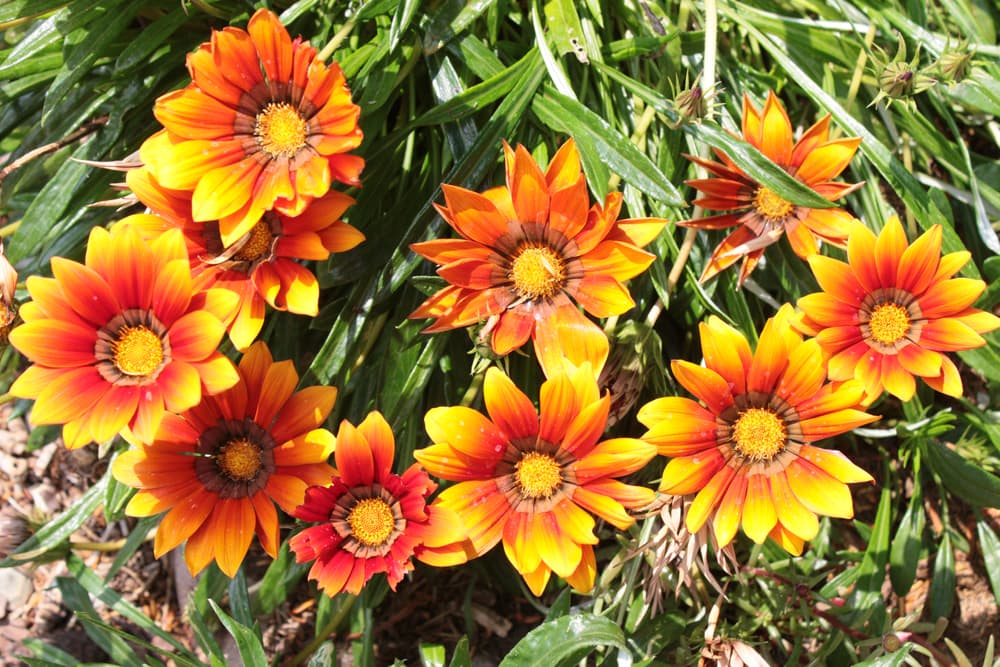
Colours are predominantly in the warm range of the spectrum, ranging from yellow through red including pink.
Perhaps it is because of the brilliant, jewel-like hues of the blooms that this plant is also called ‘Treasure Flower’.
The size of the flowers, depending on the variety, ranges from 6-12cm across, with most falling in the 8-10cm range.

The flowers are single or semi-double and, like Aster-Family flowers, many-petalled.
These ‘petals’ are technically florets – ray florets – because the ‘flowers’ are actually composite flowerheads.
What sets them apart from other members of the Aster Family is that many varieties either feature splashy radial striping on the petals or a central dark zone which is usually quite large and prominent.
They typically start blooming near the end of spring.

The cheery flowers and ‘cool’ foliage are components of what is a sporting, happy-go-lucky plant that is no trouble at all to grow and keeps free from pests and disease but attracts butterflies and birds like there’s no tomorrow.
In fact Gazanias are so easy to grow that to all intents and purposes they grow by themselves, and so much so that they are – perhaps a little unfairly – classified as weeds in Southern California, Australia and a few other regions.2Gazania spp. (2017, March). Gazania Weed Management Fact Sheet. Retrieved March 16, 2023, from https://cdn.environment.sa.gov.au/landscape/docs/hf/gazania-weed-management-fact-sheet.pdf
Most Gazania varieties bloom between mid-spring and mid-summer though under the right conditions several varieties bloom right to the end of summer and sporadically in autumn.
Habitat & Growing Conditions
Gazanias are denizens of sunny, hot and dry conditions and they make do quite well in poor soils in their native habitat of Southern Africa.3Gazania rigens. (n.d.). Missouri Botanical Gardens. Retrieved March 16, 2023, from https://www.missouribotanicalgarden.org/PlantFinder/PlantFinderDetails.aspx?kempercode=a517
This should not be taken to imply that they should be treated without care but it does mean that they should not be ‘over-cared’ for; specifically, they should not be planted in rich humusy soils or manure, not be over-watered, and not be fertilised except, perhaps, very sparingly in mid-spring.
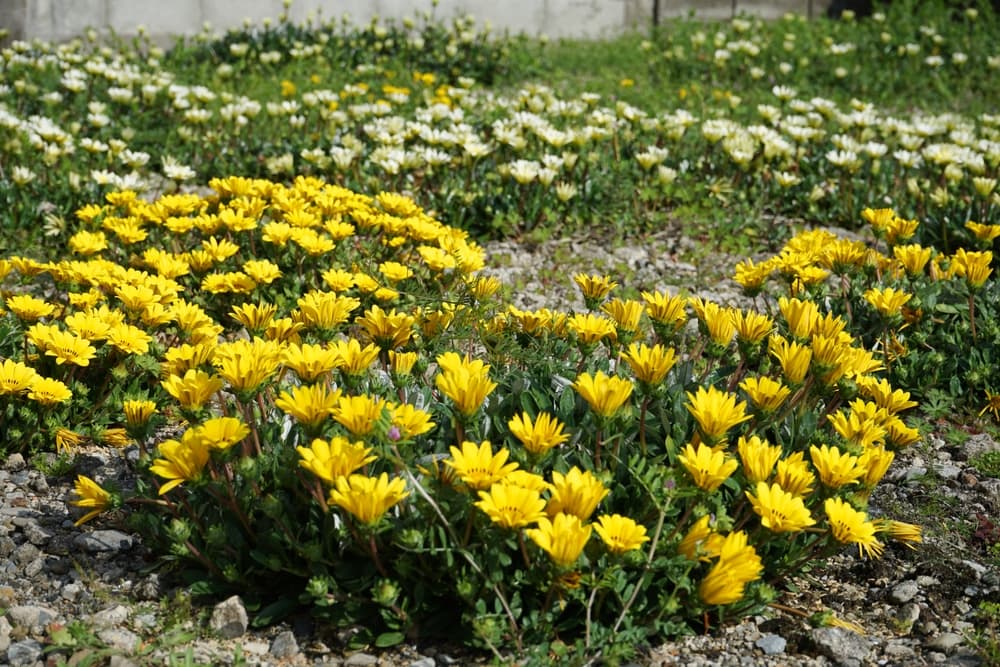
In their native region, Gazania species grow freely in open woodlands, grasslands, scrublands, and semi-arid regions.
These plants are invasive in favourable conditions, such as those outlined above.
Another habitat it favours is coastal regions as it takes very well to salt-sea spray.
Hardiness
As most species hardy to H2 and most cultivars hardy to H3, Gazanias can be perennial plants in the United Kingdom with a lot depending on the specific region of the country and the spot in the garden that they are placed in.
In the North / Midlands in an exposed location, Gazanias are grown as annuals.
Down South by the sea in a sheltered spot, they can often be grown as perennials.
In fact, Gazanias are particularly suited to coastal conditions where they also bring an ecological benefit as they control erosion in sandy and dune areas.4Gazania spp. Gazania. (n.d.). Eyre Peninsula Landscape Board. Retrieved March 16, 2023, from https://cdn.environment.sa.gov.au/landscape/docs/ep/EPLB_Gazania_Plan.pdf

How To Grow Gazania
Where you plant and how you ‘deploy’ Gazanias is strongly predicated on where you are located (in the United Kingdom) in that whether or not Gazanias can be grown outdoors as perennials.
The cultivars of the Kiss Series are one H rating more cold-hardy than the species, unlike those of the Talent Series they are evergreen, and they are decumbent, mat-forming types.
As such, they can be grown as a hugely attractive groundcover and can be used to great effect in mass plantings on embankments and slopes, especially in the southern, coastal areas of the country.
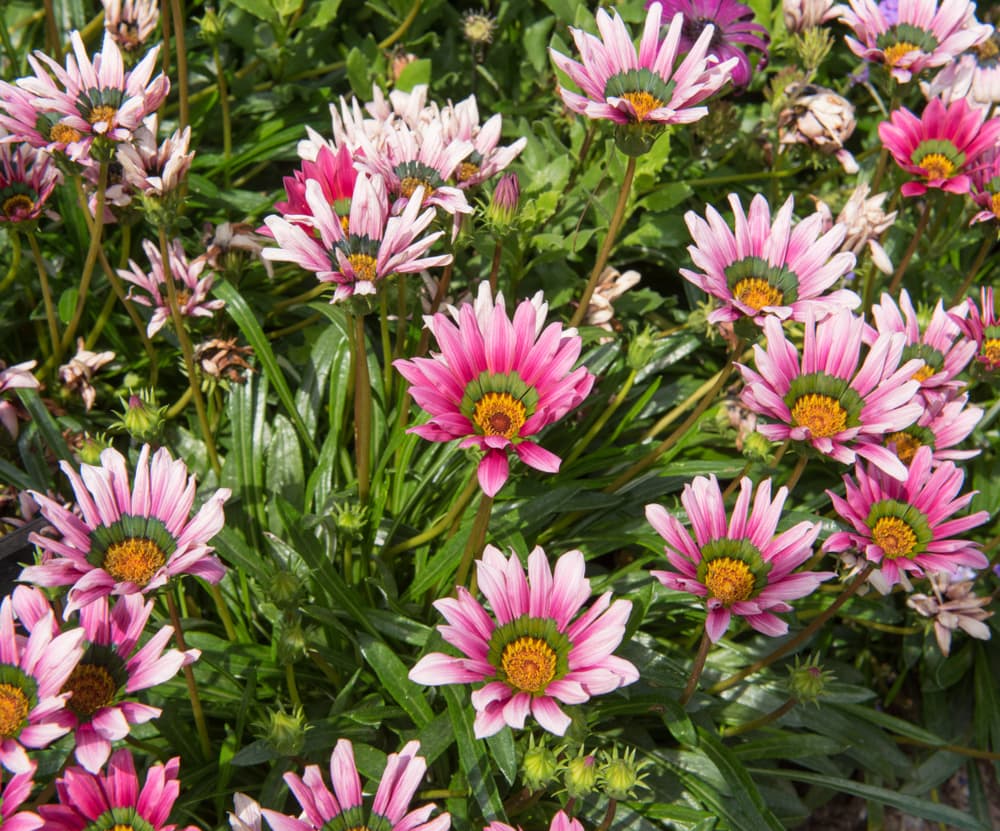
They are also wonderful choices for growing in hanging baskets and balconies as their trailing habit will produce a cascading, ‘flowing’ effect.
Clumping varieties that have a long blooming season, such as ‘Tiger Stripes’ are just as terrific for borders and edging, especially along walkways.
They are also very fine companions in beds with statelier plants whose blooms would contrast strongly with those of ‘Tiger Stripes’ or other Treasure Flowers (though the plants’ different water needs would have to be managed).

These little plants are great choices for a sunny windowsill or balcony.
No matter which part of the country you are located in, Gazanias will make cheerful annuals be they grown in beds or pots.
Gazania Plant Care
Gazania is one of those rugged plants that may not respond well to TLC.
Conversely, it will positively thrive if treated with ‘tough love’!
Accustomed to the heat and sun of Southern Africa and acclimated to dry conditions and poor soil, Gazanias are very easy to grow and need little care as to heat and soil type.
The only point on which they need care is extremes of cold as they are frost tender.
Preferred Soil
The optimal soil for Treasure Flowers is a sand-based loam that is not overly-rich with manure or compost.
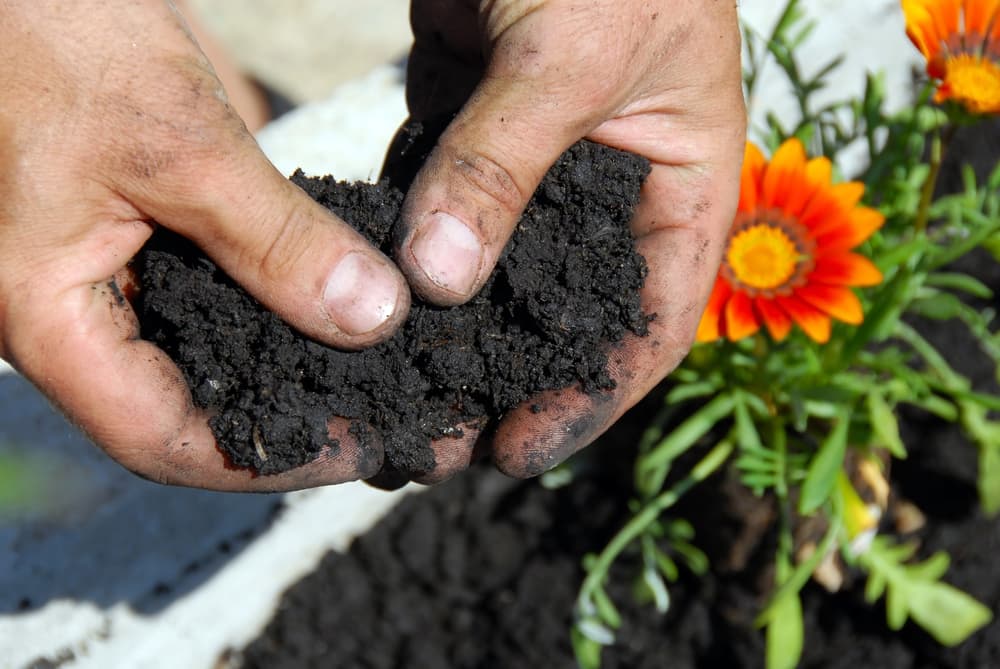
It must drain very well – these plants do not thrive in moisture-retentive soils.
The ideal soil pH is from slightly acidic to neutral, though this plant will be content in soils with pH from moderately acidic to slightly alkaline.
Aspect
In the UK they should be located in full sun.
Gazanias may be started from seed in containers indoors in winter, and transplanted outdoors or moved outside after there is no danger from frost.
The advantage of potted Gazanias is that you can move them back indoors at the end of autumn.
If they are kept toasty in a greenhouse or any warm spot indoors, they will survive the winter – however, they must get ample sunlight.

Before transplanting or moving potted Treasure Flowers outside, they should be hardened by putting them out during the day and back indoors for progressively longer durations.
Propagation
Gazanias are just as easy to grow outdoors from seed, again after there is no danger from frost.
You need do nothing more than push seeds just a tad into the soil and water them…and watch them sprout.
You can also propagate this easy-to-grow plant from basal softwood cuttings.
Take cuttings from late summer to mid-autumn and plant them in sand-based loam with additional compost or a potting soil in pots.
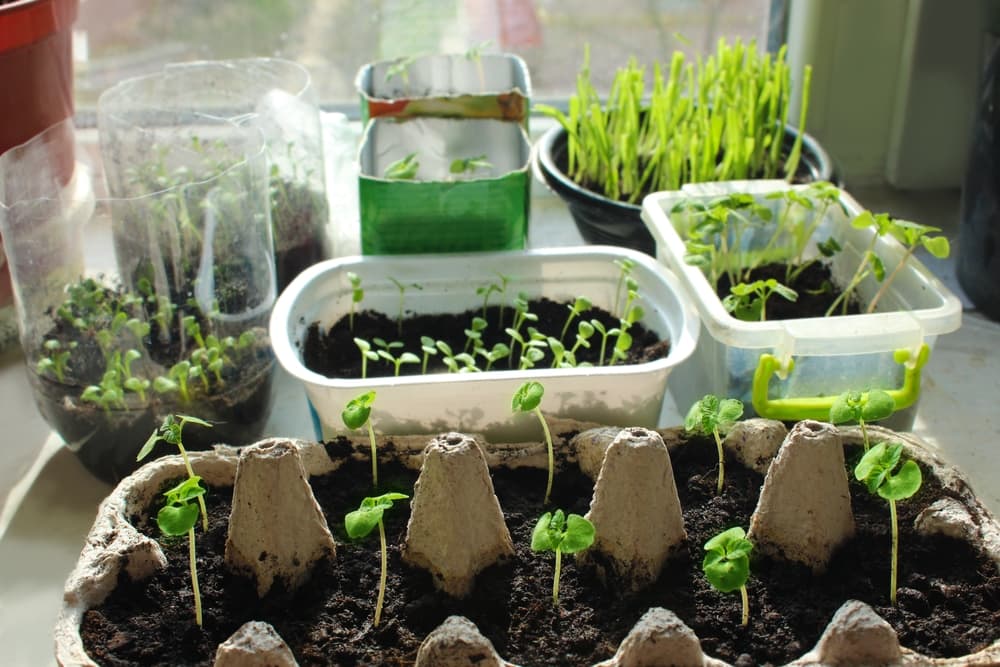
They should be kept indoors or in a greenhouse through the winter but they must get sufficient sunlight.
They can be transplanted outside in spring.
Whether you grow or transplant Treasure Flowers outdoors, space them 50-70cm apart.
“While Gazanias can be propagated by division, they have a tendency to become woody and less floriferous when divided,” shares Roy Nicol, a Master Horticulturist.
“So, starting in the spring with over-wintered cuttings means fresh, vigorous plants which will flower well over the summer and into the autumn.”
Watering
Gazanias are drought-tolerant but not ‘damp-tolerant’.
Sprinkle water moderately, even in summer – water when the soil has become dry and avoid over-watering these plants.
In some rainy regions of the UK you may not need to water outdoor Gazanias for weeks on end.
Pruning
Treasure Flower plants do not need pruning except for regular deadheading.
“It can be tricky to spot which flowers are spent when all the flowers are closed up in the morning and evening,” adds Roy.
Therefore, it’s easiest to deadhead during the day when the flowers have opened in the sunshine – spent flowers don’t open, have long stems and can be pinched out.
“Watch out for new flowers which also may not have opened yet but are close to the base and still with short stems.”

However, if you grow trailing or decumbent varieties as groundcover or for a cascading effect, you should judiciously prune, and also train, the plant for shaping and landscaping.
Upright or straggly growth should be removed and the plant should be trained and pruned to develop along the ground, or over and down the rim of a basket.
Common Problems
Gazanias are valued for being resistant to pests and for being disease-free.
Occasionally a plant may be attacked by aphids or grey mould, particularly if it is brought indoors or kept in a greenhouse for the winter.
Damp soils may lead to root rot.
Buying Gazania
The United Kingdom was one of the first regions in Europe where Treasure Flower was naturalised, and it remains one of the few countries in Europe where this plant is available at garden centres, if not very widely or in full variety.
Potted plants are available, usually in spring, in garden centres and nurseries. Varieties of the Kiss Series and Talent Series are more widely available than most.

A very good option is to buy Gazania seeds online.
References
- 1Gazania. (n.d.). Kew Royal Botanic Gardens. Retrieved March 16, 2023, from https://powo.science.kew.org/taxon/urn:lsid:ipni.org:names:331621-2
- 2Gazania spp. (2017, March). Gazania Weed Management Fact Sheet. Retrieved March 16, 2023, from https://cdn.environment.sa.gov.au/landscape/docs/hf/gazania-weed-management-fact-sheet.pdf
- 3Gazania rigens. (n.d.). Missouri Botanical Gardens. Retrieved March 16, 2023, from https://www.missouribotanicalgarden.org/PlantFinder/PlantFinderDetails.aspx?kempercode=a517
- 4Gazania spp. Gazania. (n.d.). Eyre Peninsula Landscape Board. Retrieved March 16, 2023, from https://cdn.environment.sa.gov.au/landscape/docs/ep/EPLB_Gazania_Plan.pdf

